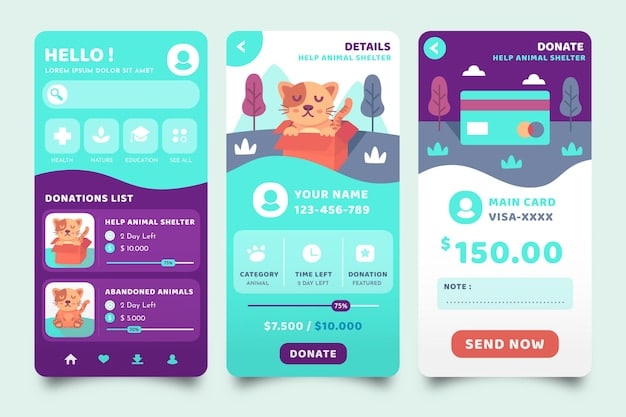DistroKid vs TuneCore: Best for Emerging US Rap Artists?

Emerging US rap artists in the US aiming to maximize royalties within the next three months often weigh between DistroKid and TuneCore, considering factors like pricing models, commission rates, and additional services offered.
For emerging US rap artists: Is DistroKid or TuneCore better for maximizing your royalties in the next 3 months? Choosing the right distribution platform can make all the difference.
Understanding Music Distribution for Emerging Rap Artists
Music distribution is the bridge between your creative work and your audience. For emerging rap artists in the US, understanding how music distribution works is crucial for getting your music heard and, more importantly, earning royalties.
Choosing the right platform can be a game-changer. Let’s delve into the basics.
The Role of Music Distribution Platforms
Music distribution platforms act as intermediaries between artists and digital music retailers (DSPs) like Spotify, Apple Music, Tidal, and more. They handle the technical aspects of getting your music onto these platforms, ensuring your tracks are properly formatted and delivered.
Key Considerations for Emerging Rap Artists
When selecting a distribution platform, several factors are paramount for emerging rap artists:
- Cost: Upfront fees or subscription models?
- Royalties: What percentage do you keep?
- Ease of Use: How simple is the upload process?
- Additional Services: Does the platform offer marketing tools, split sheets, or other benefits?
These factors directly impact your ability to earn a sustainable income from your music.
Ultimately, selecting the right platform aligns with your immediate financial goals and long-term artistic aspirations.
DistroKid: The DIY Musician’s Darling
DistroKid has become a popular choice for independent musicians, particularly those who release music frequently. Its pricing model and straightforward approach appeal to many emerging rap artists.
Let’s take a closer look at what DistroKid offers.

DistroKid’s Pricing and Features
DistroKid operates on a subscription-based model. For a fixed annual fee, you can upload unlimited songs and albums.
Pros of Using DistroKid
- Unlimited Uploads: Release as much music as you want without additional fees.
- Low Cost: Relatively inexpensive compared to per-release fees.
- Simple Interface: Easy to use, even for beginners.
- DistroKid Splits: Simplifies royalty splitting with collaborators.
Cons of Using DistroKid
- Annual Fee: You must maintain your subscription to keep your music online.
- Hidden Fees: Additional services like YouTube Content ID incur extra charges.
- Customer Service: Can be slow to respond to inquiries.
For a high-volume emerging rap artist, DistroKid’s unlimited uploads offer significant value. However, it’s essential to factor in potential hidden fees and the ongoing subscription cost.
In conclusion, DistroKid is user-friendly and can maximize royalties.
TuneCore: The Professional’s Choice
TuneCore is another prominent music distribution platform, known for its per-release pricing and a suite of additional services aimed at more established artists. While it may require a larger upfront investment, it offers features that can be beneficial for emerging rap artists with a strategic approach.
Let’s explore the specifics of TuneCore.
TuneCore’s Pricing and Features
TuneCore charges a fee per release, with different rates for singles, albums, and ringtones. They also offer a “New Artist” plan.
Pros of Using TuneCore
- No Annual Fee: Pay only for the music you distribute.
- Advance Options: Access to funding based on your streaming data.
- Direct Payment: Payment directly to artists, without intermediaries.
Cons of Using TuneCore
- Higher Upfront Cost: Can be expensive if you release music frequently.
- Limited Free Features: Analytics require a paid subscription.
- Complexity: The interface can be overwhelming for beginners.
TuneCore’s per-release pricing may be suitable for emerging rap artists who release fewer projects. Its advance options are attractive for those who seek investment in their music careers.
Therefore, TuneCore is ideal for artist with fewer volume releases.
Royalty Splits: A Crucial Factor for Rap Collaborations
In the rap world, collaboration is common. Properly managing royalty splits is essential for maintaining good relationships and ensuring fair compensation. Both DistroKid and TuneCore offer tools to help with this, but they function differently.

DistroKid Splits
DistroKid has integrated “DistroKid Splits,” which allows you to automatically divide royalties among collaborators. You can set the percentages, and DistroKid will handle the payouts.
This feature is beneficial for its simplicity and direct integration with royalty distribution.
TuneCore Royalty Payments
TuneCore does not offer its integrated royalty splitting feature. Artists must manage payouts manually, after receiving the royalties.
Best Practices for Royalty Splits
- Document Collaborations: Use split sheets to formally agree on royalty percentages.
- Communicate Clearly: Ensure everyone understands the terms.
- Use Legal Agreements: For bigger projects.
For emerging rap artists in the US, using a built-in royalty splitting feature like DistroKid Splits can save a lot of administrative headaches and potentially prevent disagreements.
Good communication and agreements are vital.
Maximizing Royalties: Tips and Strategies
Beyond choosing the right distribution platform, there are several strategies emerging rap artists can employ to maximize their royalties.
Let’s explore how active promotion and data-driven decision-making can help.
Promoting Your Music
Active promotion is key to driving streams and sales. Here are some effective strategies:
- Social Media Marketing: Build a fanbase and engage with your audience.
- Music Videos: Create videos to attract views on YouTube.
- Playlists Submission: Get your music added to relevant playlists on Spotify and Apple Music.
Leveraging Data Analytics
Both DistroKid and TuneCore provide data analytics tools. Understanding this data can inform your strategy:
- Track Streams: See where your music is being listened to.
- Identify Popular Songs: Focus on promoting your best-performing tracks.
- Target Your Audience: Tailor your marketing efforts based on listener demographics.
Data-driven decisions can lead to more targeted promotion and ultimately, higher royalties.
In summary, maximizing royalties requires both promotion and analyzing available data.
The Next 3 Months: Making an Informed Decision
Considering your specific goals for the next three months is essential when choosing between DistroKid and TuneCore. For emerging rap artists in the US, a short-term strategy can often inform the best platform choice.
First, ask yourself your goals and assess your needs.
Scenario 1: Frequent Releases
If you plan to release multiple tracks or an EP within the next three months, DistroKid’s unlimited uploads are the most economical option.
Scenario 2: Single Release with Marketing Push
If you’re focusing on a single release with a strong marketing campaign, TuneCore’s per-release pricing combined with potential access to advances could be more beneficial.
Scenario 3: Collaboration Heavy Project
On a collaboration project, DistroKid’s royalty splitting feature may be the most beneficial.
Careful evaluation of your short-term plans is useful for choosing the right option.
| Key Point | Brief Description |
|---|---|
| 💰 Cost | DistroKid: Annual fee; TuneCore: Per-release. |
| 📊 Royalties | Both platforms let you keep 100% of royalties. |
| 🤝 Collaborations | DistroKid offers built-in royalty splitting; TuneCore requires manual management. |
| 🚀 Promotion | Active promotion and data analysis are key for maximizing royalties on both platforms. |
FAQ
▼
DistroKid uses a subscription model with a flat annual fee, while TuneCore charges per release. This difference significantly impacts cost depending on the amount of music you plan to distribute.
▼
DistroKid offers an integrated “Splits” feature, allowing you to automatically divide royalties among collaborators. TuneCore does not, requiring manual management of payments.
▼
Yes, you can switch. However, you will need to remove your music from the old platform and re-upload it to the new one. Be prepared for potential downtime in your music’s availability.
▼
Promote your music through social media, music videos, and playlist submissions. Utilize the data analytics provided by the platforms to understand your audience and tailor your marketing efforts.
▼
Yes, both platforms may have hidden fees for additional services like YouTube Content ID, takedown requests, or physical distribution. Always read the terms and conditions carefully.
Conclusion
Choosing between DistroKid and TuneCore depends on your specific circumstances, release schedule, and collaborative practices. Emerging US rap artists should carefully consider their needs and plan for the next three months to make an informed selection that best maximizes their royalties.


